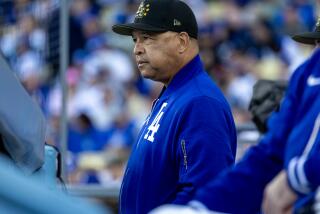The League: THE RISE AND DECLINE OF THE NFL by David Harris (Bantam: $21.95; 710 pp.)
- Share via
In an era characterized by sports pages that often read more like the business or crime beat sections in the newspapers, it is not surprising that this intriguing sports offering, “The League: The Rise and Decline of the NFL,” finds its subject in the off-the-field business machinations of the National Football League and its franchise owners.
David Harris, the author, previously wrote “Dreams Die Hard,” which described the politics and tragic death of Congressman Allard Lowenstein. Harris has switched forums to focus on the politics of the inner circle of professional football leadership in the most complete volume yet written describing the past decade of the National Football League.
“The League” documents what the author sees as the systematic erosion of NFL unity and purpose, which destroys the careful handiwork of Commissioner Pete Rozelle. Harris begins by tracing the meteoric rise of Rozelle from his early days at Compton High School and as public relations director of the Los Angeles Rams to his surprise election in 1960 at age 33 as commissioner of the NFL.
Harris shows Rozelle displaying creativity and consensus-building in the early years of his reign, transforming the NFL into the nation’s most powerful sports monolith. The narrative begins in 1974 with Rozelle presiding unchallenged over a wealthy and basically harmonious league. Al Davis, owner of the then Oakland Raiders, who would later become Rozelle’s chief nemesis, characterized Rozelle at that point as “the most powerful man in professional sports.” Clint Murchison, then owner of the Dallas Cowboys, described Rozelle as a man with “milk toast all over his high hand.” Harris adds that “in 1974 it was widely assumed that his (Rozelle’s) twenty-six employers were putty in his hands.”
Rozelle adopted as his key administrative touchstone the concept of “League Think” in which the owners would place the larger common benefit of the NFL ahead of their own ego and personal interests. Harris quotes Art Modell, owner of the Cleveland Browns, proclaiming: “While there is no love lost on Sunday, it’s all for one and one for all the rest of the time.”
Rozelle’s “League Think” policies of sharing television revenue, limiting expansion, carefully controlling franchise shifts, and prohibiting non-NFL cross-ownership are shared by his allies in the League’s “Old Guard,” but are challenged heavily by owners with a different vision like Al Davis.
The author illustrates that “over the next decade he (Rozelle) would be denigrated, deplored, challenged, and bested in the most public of ways . . . in the end both his vision of the football business and the majesty he claimed for his office would be torn to shreds.” This conclusion may not be totally justified. As the employee of a diverse group of volatile and powerful millionaires, Rozelle could be complimented for forging as much unity as he did.
When Harris shifts focus to the owners themselves, his keen descriptive eye for color and detail brings “The League” to life. The author highlights a fascinating collection of personalities and life styles that often seem lifted from the television shows “Dallas” or “Dynasty.”
Gene Klein, dedicated and earnest one-time owner of the San Diego Chargers, begins his business career by weighing used cars and selling them by the pound with commercials advertising them as “Cheaper Than Hamburger.”
High-rolling and Runyonesque one-time Philadelphia Eagles owner Leonard Rose refuses to allow his wife to wear the same dress twice, travels with separate limousines for himself and his luggage, and runs up a gambling debt in Atlantic City one night of more than $1 million.
Lamar Hunt, mild-mannered owner of the Kansas City Chiefs, loses $1 million in his first year as a founder of the American Football League. When asked to comment on his son’s losses, H. L. Hunt is quoted by the author as exclaiming that “at this rate, the boy has only 123 years to go.”
Georgia Frontiere breaks the gender line among the owners when she inherits the Los Angeles Rams from her deceased husband, Carroll Rosenbloom, who dies in a tragic swimming accident.
After exploring the lighter side of many owners’ life styles and characters, Harris painstakingly reconstructs an era filled with internal and external strife on multiple fronts as the calm veneer of the NFL masks steady conflict. Harris shows owners refusing to divest holdings in other sports, facing allegations of Super Bowl ticket scalping, intimidating municipalities into building new stadiums or sweetening leases by threatening relocation, battling with minority partners for control of franchises, facing financial ruin through heavy debt, and challenging the concept of “League Think” at every turn.
Harris views the crowning blow to Rozelle’s vision and control as the successful effort of brilliant strategist Davis and dedicated Los Angeles labor leader Bill Robertson to bring the Raiders to the Los Angeles Coliseum. Davis, perhaps the most free-thinking and visionary of all NFL owners, moves the Raiders to Los Angeles without league authorization and then sues the NFL for antitrust violations when it resists the move.
The author comments that during this time, the league had to fight “a trade war” with the USFL, “a labor war” with the players’ union, and a “civil war” with Davis “all at the same time.” Harris concludes that the NFL’s defeat by Davis has ushered in a new era of decreased league unity and commissioner authority. But has it? Certainly the National Football League does face a significant challenge with its collective bargaining agreement and television contracts expiring at the conclusion of the 1986 season, but this summer has seen the NFL set the stage for the demise of the USFL by defeating its antitrust lawsuit, and 1986 attendance and television ratings may post all-time records.
Harris has compiled an impressive and fascinating study that illuminates a previously little-explored world. It is hard, however, to view a commissioner whose reign has outlasted three competitive leagues, has helped ensure tremendous profitability for owners by settling two player strikes, and who negotiated a series of television contracts that exploded broadcast revenue by $15 million yearly per team, as a shattered failure. And whatever the fate of “League Think,” it is difficult to consider a league governing what still is the most popular professional team sport in America as a decaying empire.
More to Read
Go beyond the scoreboard
Get the latest on L.A.'s teams in the daily Sports Report newsletter.
You may occasionally receive promotional content from the Los Angeles Times.










